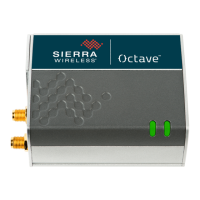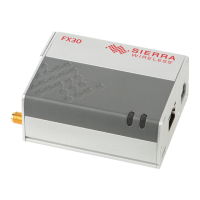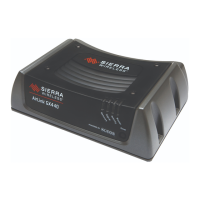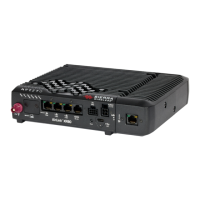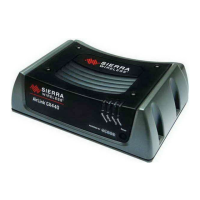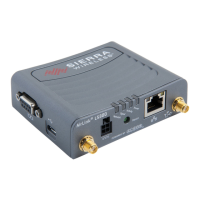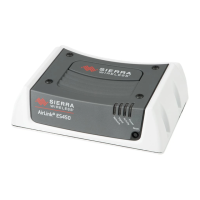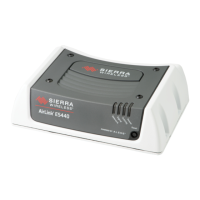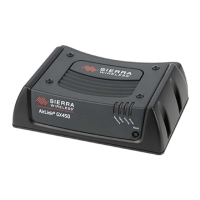Do you have a question about the Sierra Wireless FX30 and is the answer not in the manual?
Lists the main hardware and software capabilities of the FX30.
Explains the different power states available for the FX30 device.
Lists the included and optional accessories for the FX30.
Information on the warranty period and terms for the FX30.
Lists the necessary tools and materials for installing the FX30.
Detailed instructions for installing the SIM and IoT Expansion cards.
Guidance on physically mounting and grounding the FX30 unit.
Instructions for mounting the FX30 on a flat surface.
Method for securing the FX30 in high vibration areas using cable ties.
Instructions for mounting the FX30 onto a DIN rail.
Steps for connecting the cellular and GNSS antennas.
Instructions for connecting USB and Ethernet data cables.
Best practices for routing cables away from sharp edges.
Guide to connecting the DC power and I/O pins.
Details the functions of power connector pins and DC cable wires.
Diagrams illustrating different wiring configurations for power and I/O.
Explains the configurable I/O options for the FX30 power connector.
Details the various ways the I/O pins can be utilized.
How to use I/O pins as digital inputs to detect states.
Using I/O pins with high side pull-up for switch inputs.
How to connect and use the FX30's analog input capabilities.
Using I/O 3 as a low side current sink for driving relays.
Using I/O 3 for digital output or open drain configurations.
Steps to verify the FX30 is operating correctly after installation.
Explains the meaning of the Power and User LEDs.
Overview of how to use the FX30 after setup.
Steps to configure the FX30 for use with a Windows computer.
Common AT commands for controlling the FX30's modem functions.
Examples of Linux shell commands for interacting with the FX30.
Maps FX30 interfaces to their Linux system counterparts.
Methods for managing I/O interfaces using AT commands or Linux.
Procedures for resetting the FX30 to its factory default configuration.
Lists the certifications and standards the FX30 complies with.
Details the environmental tests performed on the FX30.
Describes the various host interfaces available on the FX30.
Information about the SIM card slot and its capabilities.
Lists the supported radio frequency bands for the FX30.
Specifies the conducted transmit power for different radio modules.
Provides dimensions, weight, and mechanical details of the FX30.
Details the three power modes: OFF, Ultra Low Power, and Active.
Explains the function and control of the FX30's OFF mode.
Describes the Ultra Low Power Mode (ULPM) and its wakeup triggers.
Details the different states within Active Mode.
Provides power consumption figures for different operating modes.
Information on compatibility and interfaces of IoT Expansion cards.
Details the pin configuration of the IoT Expansion Card.
Maps IoT connector signals to FX30 hardware and Linux interfaces.
FCC compliance and warnings for users in North America.
Guidelines for RF exposure and antenna placement.
Specifies the maximum allowable antenna gain for compliance.
EU compliance statements and CE marking information.
Details of the DC power cable, including part number and components.
Information about the AC power adapter.
Input voltage and frequency specifications for the AC adapter.
Output voltage and current specifications for the AC adapter.
Lists the safety certifications obtained by the AC power adapter.
Details the EMC standards met by the AC power supply.
Information on the energy efficiency levels of the AC adapter.
Steps to connect the FX30 to a cellular network.
Instructions for activating the Packet Data Protocol (PDP) context.
Steps to properly deactivate the active PDP context.
How to manage the FX30's I/O interface using AT commands.
AT commands specific to controlling General Purpose Input/Output (GPIO) pins.
AT commands for configuring and querying Ethernet settings.
AT commands for configuring and querying USB settings.
AT commands to query device type and version information.
AT commands related to the factory default recovery mechanism.
Mapping and description of the On/Off pin functionality.
Mapping and description of the I/O 1 pin functionality.
Mapping and description of the I/O 2 pin functionality.
Mapping and description of the I/O 3 pin functionality.
Mapping of Power LEDs to Linux interface and their behavior.
Mapping of User LEDs to Linux interface and their behavior.
Maps FX30 functions to WP module and processor GPIO numbers.
Information regarding eSIM support and SIM slot configuration.
Details the automatic SIM card carrier configuration feature.
Customization for selecting the preferred SIM slot.
Configuration for the polling interval of AirVantage Management Services.
Configuration settings for the device's UART ports.
Lists the main hardware and software capabilities of the FX30.
Explains the different power states available for the FX30 device.
Lists the included and optional accessories for the FX30.
Information on the warranty period and terms for the FX30.
Lists the necessary tools and materials for installing the FX30.
Detailed instructions for installing the SIM and IoT Expansion cards.
Guidance on physically mounting and grounding the FX30 unit.
Instructions for mounting the FX30 on a flat surface.
Method for securing the FX30 in high vibration areas using cable ties.
Instructions for mounting the FX30 onto a DIN rail.
Steps for connecting the cellular and GNSS antennas.
Instructions for connecting USB and Ethernet data cables.
Best practices for routing cables away from sharp edges.
Guide to connecting the DC power and I/O pins.
Details the functions of power connector pins and DC cable wires.
Diagrams illustrating different wiring configurations for power and I/O.
Explains the configurable I/O options for the FX30 power connector.
Details the various ways the I/O pins can be utilized.
How to use I/O pins as digital inputs to detect states.
Using I/O pins with high side pull-up for switch inputs.
How to connect and use the FX30's analog input capabilities.
Using I/O 3 as a low side current sink for driving relays.
Using I/O 3 for digital output or open drain configurations.
Steps to verify the FX30 is operating correctly after installation.
Explains the meaning of the Power and User LEDs.
Overview of how to use the FX30 after setup.
Steps to configure the FX30 for use with a Windows computer.
Common AT commands for controlling the FX30's modem functions.
Examples of Linux shell commands for interacting with the FX30.
Maps FX30 interfaces to their Linux system counterparts.
Methods for managing I/O interfaces using AT commands or Linux.
Procedures for resetting the FX30 to its factory default configuration.
Lists the certifications and standards the FX30 complies with.
Details the environmental tests performed on the FX30.
Describes the various host interfaces available on the FX30.
Information about the SIM card slot and its capabilities.
Lists the supported radio frequency bands for the FX30.
Specifies the conducted transmit power for different radio modules.
Provides dimensions, weight, and mechanical details of the FX30.
Details the three power modes: OFF, Ultra Low Power, and Active.
Explains the function and control of the FX30's OFF mode.
Describes the Ultra Low Power Mode (ULPM) and its wakeup triggers.
Details the different states within Active Mode.
Provides power consumption figures for different operating modes.
Information on compatibility and interfaces of IoT Expansion cards.
Details the pin configuration of the IoT Expansion Card.
Maps IoT connector signals to FX30 hardware and Linux interfaces.
FCC compliance and warnings for users in North America.
Guidelines for RF exposure and antenna placement.
Specifies the maximum allowable antenna gain for compliance.
EU compliance statements and CE marking information.
Details of the DC power cable, including part number and components.
Information about the AC power adapter.
Input voltage and frequency specifications for the AC adapter.
Output voltage and current specifications for the AC adapter.
Lists the safety certifications obtained by the AC power adapter.
Details the EMC standards met by the AC power supply.
Information on the energy efficiency levels of the AC adapter.
Steps to connect the FX30 to a cellular network.
Instructions for activating the Packet Data Protocol (PDP) context.
Steps to properly deactivate the active PDP context.
How to manage the FX30's I/O interface using AT commands.
AT commands specific to controlling General Purpose Input/Output (GPIO) pins.
AT commands for configuring and querying Ethernet settings.
AT commands for configuring and querying USB settings.
AT commands to query device type and version information.
AT commands related to the factory default recovery mechanism.
Mapping and description of the On/Off pin functionality.
Mapping and description of the I/O 1 pin functionality.
Mapping and description of the I/O 2 pin functionality.
Mapping and description of the I/O 3 pin functionality.
Mapping of Power LEDs to Linux interface and their behavior.
Mapping of User LEDs to Linux interface and their behavior.
Maps FX30 functions to WP module and processor GPIO numbers.
Information regarding eSIM support and SIM slot configuration.
Details the automatic SIM card carrier configuration feature.
Customization for selecting the preferred SIM slot.
Configuration for the polling interval of AirVantage Management Services.
Configuration settings for the device's UART ports.
| Processor | ARM Cortex-A7 |
|---|---|
| Operating System | Legato Linux |
| Wi-Fi | 802.11 b/g/n |
| Bluetooth | Bluetooth 4.1 |
| Ethernet | 1 x 10/100 Mbps |
| Serial | 1 x RS-232 |
| Operating Temperature | -30°C to +70°C |
| Memory | 512 MB RAM, 4 GB Flash |
| Cellular | LTE |
| USB | USB 2.0 |
